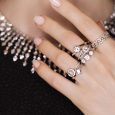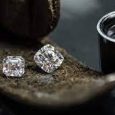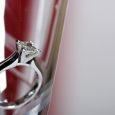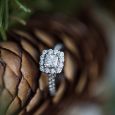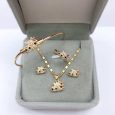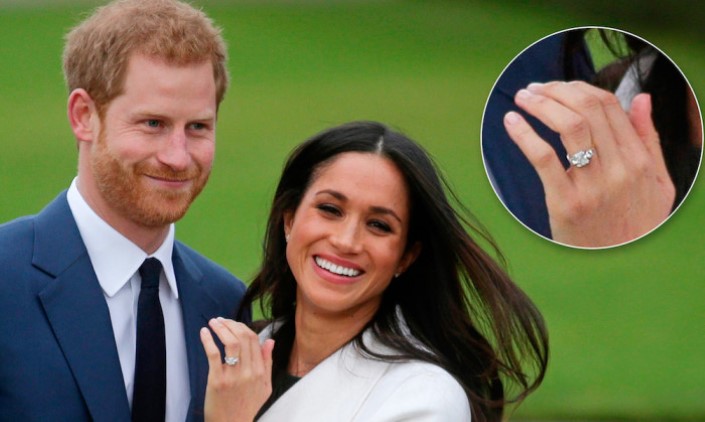
You’re here researching about diamonds so you can make the best possible decision. That’s very smart because there are so many important diamond products on the market today. You must do your homework. With that in mind, have you heard of the term laser-drilled diamonds? It may not be familiar to you, and that’s ok, because this article will explore what you need to know about both laser drilled diamonds, and another diamond type, the HPHT diamond. To learn what this means, read on. Let’s examine what laser drilling actually is, and then you can determine for yourself whether you should buy diamonds that have undergone this special treatment.
In layman’s terms, laser drilling simply expresses a specialized process of enhancing the clarity of a diamond—any diamond at all. This specialized procedure wholly depends on utilizing super-fine lasers in a laboratory setting to drill minute holes (really much thinner than a human hair) into the stone, from its surface (exterior of the crystal) to an inclusion which may be deep inside. This newly created channel is then used to remove the intended inclusion which negatively affects its clarity grade by either 1) melting the targeted blemish with extremely high heat or by dissolving it completely out of the crystal inside through the use of acid.
Laser drilling is a very effective means of raising the clarity grade of a diamond
This unique process involving the targeted use of lasers to drill these nearly invisible holes (thinner than a hair) in the diamond which has been selected for its overall quality other than its clarity grade. So, the end result after the treatment is one of a very attractive diamond that far exceeds most consumers expectations—and yet, surprisingly, it is quite affordable.
This channel created by the laser treatment, is then the safe and effective way to dislodge and remove the inclusion by either melting it via intense heat or sometimes dissolving it with a proprietary acid used only for this purpose.
Not all diamonds are candidates for the process. Consumers will be pleased to learn that most of the other –or even all of the other quality characteristics are considered high-quality—with the one exception of its clarity grade. So once that is resolved, the consumer has a gorgeous diamond that they can be proud of for the rest of their life. And no one needs to know anything about this brilliant stone. Anyone admiring your diamond will simply see a fantastic stone; one that is clear, brilliant and very bright. Laser drilling is usually conducted in the lab to target the more obvious inclusions such as black spots. Many of the lighter ones actually go unnoticed. So the decision is strategic as to when and where to conduct lasering on a diamond.
Are Laser-Drilled Diamonds a Good Choice?
Now that you Have heard the term laser-drilled diamonds, if you still may be wondering what this means to you as a buyer, so read on. We’ll examine what laser drilling does and whether you should purchase diamonds treated this way. You already know the budget you have set aside most likely and you’ve probably studied lots of diamond shapes and sizes, plus looked at settings. So, the big part of your job is already done. The one thing that will take you by surprise is how large and brilliant of a diamond you are able to buy with choosing a laser treated diamond. You want the best for your money, but when you have to select only the un-treated diamonds, you’ll find that your money goes not so far. Yes, the stone will be un-treated which is good, but it will have to be quite small to stay inside your budget. But only you can choose if buying an untreated or a laser treated diamond is the right option in your situation.

How Is Laser Drilling different from untreated diamonds?
These are the main points to keep in mind, aside from the technical information about laser drilled diamonds;
Drilling tiny channels within a diamond can effective improve the clarity grade of a stone.
Laser drilling is a proven way to enhance the clarity of a diamond and improve its appearance.
This specialized process involves lasers to bore miniscule holes (a lot thinner than a human hair) into the interior of a stone, starting from its surface and going completely into an inclusion inside the crystal.
This drilled out channel clears the way to remove any inclusion by one of two methods– either by melting the foreign matter using heat or by dissolving anything left in the channel after the drilling with an acid.
Laser drilling is the preferred method of increasing a clarity grade and removing the more obvious inclusions such as black spots which negatively impact a stone’s beauty.
How Much Can I Expect Laser Drilling to actually Improve Clarity?
Here is something vital to learn: Most often, the diamond’s clarity improvement that will be seen in a laser-drilled diamond immediately and quite drastically and you should expect to see about one grade up.
Let’s say for example, you have a diamond graded I1. Many diamonds are in that category and can benefit from strategic laser drilling to remove some of the more obvious inclusions. This treatment should accomplish bumping the diamond clarity up into at least the SI range (thus turning the diamond into an SI2 or SI1 stone). The increase is a dramatic one and will heavily impact its beauty.
In some cases, the stone experiences a greater clarity jump—but that’s not always the case. That’s because it is actually rare to see an improvement of more than two grades. So, you need to understand your expectations. It’s not completely impossible to see such a big jump, but what happens is that it all comes down to a tradeoff between the improved looks of the treated stone and its sturdiness. The greater the clarity improvement often the more drill holes it had placed in the crystal. The more channels that were drilled into the diamond, the weaker its structure can result. Top notch treated diamond dealers today understand these risks and benefits—and work tirelessly to create a beautiful balance between how much drilling makes sense, and what are the expectations. This process is indeed part science and part art—the results are a diamond that everybody wants.
A word of Caution: Laser Drilling Must Be Disclosed if it’s Reputable Dealer

We found some unusual regulations—or rather lack thereof, when it comes to disclosing the treatments that are applied to beautiful diamonds through laser enhancement. In the U.S., the FTC, or Federal Trade Commission, doesn’t require the explicit disclosure of laser drilling enhancements when diamonds are sold in the retail setting. But you will notice that reputable treated diamond dealers, whether they are e-commerce only or have a brick and mortar store will not only clearly display that the diamonds are enhanced in some way—but they will proudly display the fact. They want prospective customers to understand how much value they can expect to have with their treated diamond. For the money they spend, they will indeed be getting a bigger, brighter and clearer diamond than they ever felt they could afford. This is very important today, as most shoppers are looking for the best value they can find when purchasing a big-ticket item like a diamond.
Here are some of the details as to why there are no regulations specifically addressing the disclosure aspect of diamond selling. When the laser treatment has been completed, this new change in the stone’s clarity is permanent of course. So for example, if you purchase an enhanced diamond that was improved up from say, SI2 to an SI1, that diamond remains an SI1 stone forever. So the consensus from some groups is that it does not need disclosure. This is where you’ll see the standards set by top-treated diamond dealers. The process is so technical and the achievements are so outstanding that they want to make sure the consumer understands the fine product they are getting, and the consumer should be proud to make an enhanced diamond purchase—it shows aforethought, savvy understanding of diamond products on the market today and wise use of hard earned money.
Disclosure regulations can always change, of course. And while they don’t modify the rules frequently, public concern and demands affect the slow winds of change. Simply put, as a customer you should do the best to understand all the varieties of diamond products on the market today—the benefits and drawbacks to each one—and then make an informed decision so you can be proud of your purchase and be set to enjoy your diamond for the rest of your life. This is a wise idea– Ask explicitly with the diamond merchant where you want to buy your stone. Check to see if the diamond you are intending to buy has actually been laser-drilled, especially if there’s no mention of such a treatment in writing. Your diamond receipt should spell out everything very clearly so that you have it in writing, exactly what you bought in case you need to compare and contrast the quality later on for some reason.

Even in the best-case scenarios, why do you think it so important to know if your diamond has been treated in any way prior to purchase? Well, as it turns out, something like laser drilling can sometimes cause problems if you have not acquired your stone from a reputable dealer who has been in the business a good long time. The older dealers have excellent connections to bring you the best diamonds at good prices. They also declare the procedures that they have done to your diamond prior to you buying it—and here’s what’s important—they put it in writing on your sales receipt. You can feel good about these dealers—confident in their trustworthiness and also the quality of the goods they offer.
Good to Know about Laser Drilling
Drilling tiny channels within a diamond may weaken its structure if not done correctly with discernment about the entire stone being treated. This could be true even if the effect is not significant at all. In most cases you encounter today, diamonds that have been laser drilled will actually hold up very well as long as the number of drill holes are not too many. That’s good news for consumers considering buying a laser drilled diamond. They want—and you want your money to be well spent. The object is to enjoy the diamond for years, not just during the first few months you own it.
The only problem with durability that ever comes into play and becomes more serious is when there were a lot of tunnels drilled in that particular stone. Because laser drilling is such an established procedure these days, we do not see this situation pop up much anymore.
You should keep in mind that removing an such natural inclusions this way not only leaves a small channel within the diamond but by its drilling, it also leaves an empty space where the removed inclusion (or blemish) originally appeared.
As a general rule, be wary of any diamonds with too many drill holes. Ask the vendor how much treatment the particular stone you like has undergone. And discuss the integrity of the treated stone now that lasering has occurred. A reputable dealer will be very forthcoming. Actually, they are not likely to carry stones which fail to meet standards of integrity. If you happen to buy a laser treated a stone, remember that you will want to protect it more carefully than other non-treated diamonds–specifically against accidental hits or bumps, as these events may cause the diamond to become compromised.

Can You Tell If Your Diamond Is Laser Drilled?
This one is obvious—but certainly the easiest way to find out if your diamond has been laser drilled is by looking at its certificate that your retailer gave you. Diamond reports issued by GIA (Gemological Institute of America) for instance, will list the drill holes in the examined stone, if there are any. There are other independent gem labs of course, that also deliver diamond reports, and your diamond may have been examined by one of those besides GIA.
But depending on where you purchased your diamond, it may not come with its own certificate. When you don’t have a diamond report, or if you just want to inspect the stone for yourself while you are still in the store, you can always ask to see the diamond under a microscope. If you’re not used to looking at stones under a scope, it will take a bit of getting used to, to accustom your eyes to looking for blemishes, inclusions and the like. Such an inspection, however, allows you to see firsthand just how many channels were drilled into the stone you are about to buy.
How Much Laser Drilling Improves its Clarity?
More often, a stone’s clarity improvement that can be seen (some of the lasering is extremely subtle) in a laser-drilled diamond is about one grade up. But that’s a big deal when considering subtle changes in improvement can positively affect its value.
When you go shopping for a diamond engagement ring, you probably already have a sense of the hefty prices a diamond with high color and clarity can cost. Whether you’re still on to make your first million, or, if you simply don’t want to pay 40 thousand dollars for a diamond—when there are other things you could use the money for, then laser drilled diamonds will be the ideal choice for you. You get the look, the beauty, and large carat size—while still keeping an eye on your budget.
To be sure, there are abundant alternatives in purchasing your all-important engagement ring, natural diamonds do possess intrinsic qualities unrivaled by any other gemstone on earth. Their sheer brilliance and attractiveness has been celebrated by aristocracy and royal households abroad and coveted since early civilization. Diamonds have evolved into symbols of love, commitment and affluence; prized by men and women the world over, and across every culture. Even scientists are captivated by their unique durability and fascinating molecular composition.
What makes Laser Drilled diamonds a real catch?
There are other treatments Unless disclosed, laser drilled diamonds do not have any filling. They are as brilliant and stunning as a non-drilled diamond of the same clarity although they have had the special touch of technology applied to them. In addition, laser drilled diamonds require no special handling other than what you would give to all your fine diamond jewelry. They can be handled like any other natural diamond—and remember, laser drilled diamonds are actually earth mined genuine diamond given a special beauty treatment. All rough diamonds are cut and polished to improve their appearance; and in the same way, a diamond might be drilled to achieve its maximum beauty as well.
Here’s the background on improving a diamond’s clarity grade
By the late 19th century a surge in the global diamond supply prompted what we understand today as diamond grading. This universally understood grading system was and still is used to rank the overall diamonds’ quality; with clarity being one of the prime characteristics measured which determine the stone’s rarity, value and beauty. Diamonds appearing naturally created and noticeably dark inclusions fell into a lower ranking of marketability as compared to their eye-clean counterparts. This method of sorting lead to establishing today’s universal grading system we still use now across the globe. This paved the way to monetize and communicate a diamond’s physical properties without ever actually seeing the stone in some cases.
Still, for nearly a century, it was impossible to eradicate those dark inclusions occurring within the stone. Step by step, the whole process eventually became easier with the creation of the diamond saw. This allowed manufacturers to remove unwanted carbon spots by sawing into the rough and removing the problematic dark spots that way. However, it merely offered a limited ability to effectively remove the dark spots. It wasn’t until the mid-20th century that the trade started using laser technology. It was actually in the 1980s when lasers offered the option for dark inclusions to be removed in a precise and judiciously controlled manner. This is what we now call laser drilling and it’s done across the globe by manufacturers wanting to give their customers a beautiful large stone—and importantly, one that is affordable to many people.
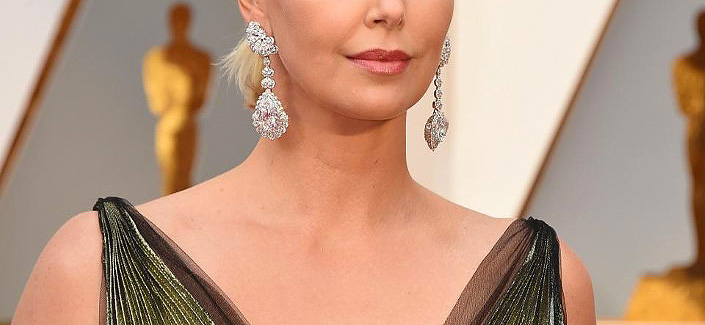
Looking at Before vs. after laser drilled diamond enhancement
When artfully executed, laser drilling diamonds can improve the diamond’s appearance by one or in some cases, up to two grades. In practical application, look at it this way; a diamond starting out with an I2 clarity can later be elevated to an SI2 or SI1 after treatment. That’s a bid deal. If you had to buy a diamond in the better clarity grade that was not treated, you’d be adding several thousand dollars to the cost of your stone.
Is there a price advantage between non-lasered diamonds vs. laser drilled ones?
Depending on several variables, which when discussing natural diamonds means certain quality affecting characteristics; carat weight, color, clarity, cut, symmetry, polish and more. You can expect your laser drilled diamond to be priced significantly lower than its counterpart that has not undergone this process. As a general rule, the price of your laser drilled diamond should be anywhere from 30 % below its un-treated counterpart, to around 50-60% less.
When comparing these differences based on price, we have selected two cushion cut diamonds offered at the same price as our example of comparison. And, the 2.05-carat laser drilled diamond rates higher on color, clarity, polish, and symmetry. Because of the overall totality of these combined characteristics, it appears whiter with more sparkle and fire than the non-laser drilled diamond. Everyone should be happy with these observations. And both diamonds examined will have been done so in similar lighting conditions.
Does this mean that laser drilled diamonds are better than those not treated?
Many shoppers, especially those new to the process of investigating prices prior to actually buying a diamond are unaware that there is more choices today when it comes to buying a really beautiful natural diamond.
The intent of this conversation is not to persuade or dissuade your choices when purchasing a stone. This is up to you. But the more you know before you shop, the more satisfied you’ll be with your selection. You are meant to enjoy your diamond for an entire lifetime, so this is key to learning first before you buy. Rather, this discourse is to educate prospective diamond buyers like yourself on available choices you can consider. Laser drilled diamonds present an ideal option for modern consumers desiring more beautiful sparkler together with higher carat weights and clarity at a more attainable price point. All this is a pretty tall order, by today’s savvy shoppers still want to know they have selected a gorgeous, genuine diamond mined from the earth. Laser drilling offers this important short list—and does it brilliantly.
Can I see a laser drilled diamonds before I buy?
Simply stated, laser drilled diamonds are highly desirable to knowledgeable consumers who are value shopping but don’t want to lose the beauty of their stone in the process. When they come on the market, they are often a quick sell, as shoppers see the value they’re getting and they understand that each stone is one of a kind. They need to decide quickly when they’ve found the stone of their dreams. If not, there’s another anxious customer who will grab that stone. In addition, jewelers may carry them proudly because they represent such a value, even though they may have millions invested in traditional diamond products. It’s a good idea to consult with a reliable diamond supplier offering all types of diamonds; like certified non-enhanced, GIA certified natural HPHT, laser drilled, and even clarity enhanced. This is the best way that your consultant can provide an unbiased observation for you to be fully informed and end up getting the diamond which is perfect for you on every level.

Does GIA normally certify Enhanced Stones?
When GIA takes in someone’s diamond for certification, they thoughtfully inspect it for any manmade procedures that it may have had done to it. This examination includes observation for color coating, laser drilling, HPHT (high pressure high temperature) which we will now discuss, and even fracture filling. Because all of these treatments mentioned are specifically designed to boost the clarity or color of that treated diamond. Having said that, if GIA determines that a diamond has had a procedure that’s considered to be temporary or could even risk damage to the stone in future, it will not produce a grading report for that diamond. The specific procedures that prevent a particular stone from receiving its GIA grading report are fracture filling or diamond coating. These effects can potentially be removed at some point in time or possibly during a cleaning.
The HPHT Discussion—as it compares to Laser treated Diamonds
Since we’ve gone over so many elements of the laser treated process, from what is involved with it to how it affects the beauty, and salability of the diamonds, its now time to turn our attention to another technological advancement called HPHT. Not every procedure done on a diamond automatically excludes that stone from being graded in an independent lab. For example, GIA does issue reports for loose diamonds which has gone through laser drilling or even the HPHT treatment.
We’re going to explore HPHT treatment to learn where that fits into the treated diamond sector and discover if that is something you want to look into when buying your diamond. If it has been concluded that a diamond has had either of these procedures, then GIA will ensure that both consumers and retailers are completely aware of this procedure by indicating it on the final report. GIA reports will even mark diamonds that have been HPHT processed as a straightforward method of alerting potential purchasers that have not yet seen the grading report.
Bear in mind that such grading reports will help guarantee that you are well informed and getting a fair deal with your purchase. This way, you will be competent to resell it for fair value if that is ever required in your future. Since you cannot attain a GIA report for many enhanced diamonds it’s always a good idea to buy a diamond that you know exactly what treatments if any have been done to your stone. Now let’s dig deeply into the process called HPHT and what that means for the consumer. Is it a good thing? Do HPHT diamonds offer something special that consumers need to learn about? Is an HPHT diamond right for you? Let’s see.
What is HPHT in regards to diamonds?
HPHT treatment is a specialized modern diamond process that is very similar to what happens in nature with diamonds. Literally it is like putting the diamond back into the environment in which it was originally formed billions of years ago some 125 miles below the surface of the earth. In brief, HPHT diamonds are genuine, earth-mined diamonds. They are a good choice for diamond shoppers wanting top color and of course clarity, all at a substantially lower price. And they would like them to be accompanied with a GIA or EGL certificate.
How are HPHT diamonds created?
The first synthetic method the HP part, is called high pressure, and the second part is high temperature (or HPHT as the trade calls it). It’s actually the closest thing to the diamond-producing unseen depths of the earth, subjecting graphite — yes, the same basic material found in your No. 2 pencil. Both diamonds and your pencil are made from a pure carbon mineral that was exposed to intense pressure and heat over a very long period of time—like billions of years to be exact.
HPHT is a trade term basically standing for high pressure — high temperature. It is a fascinating method of applying HPHT in a laboratory environment to certain diamonds that are not fully crystallized sometimes called premature diamonds when they were released from their fiery, erupting volcanoes. The HPHT process as a scientific procedure is carefully controlled in the lab. Think of it this way; an HPHT process is applied to finish what nature began under the earth by applying 70,000 atmospheres (which are identical atmospheric-pressure that a diamond experiences in the ground) at temperatures of up to 3,700°F.
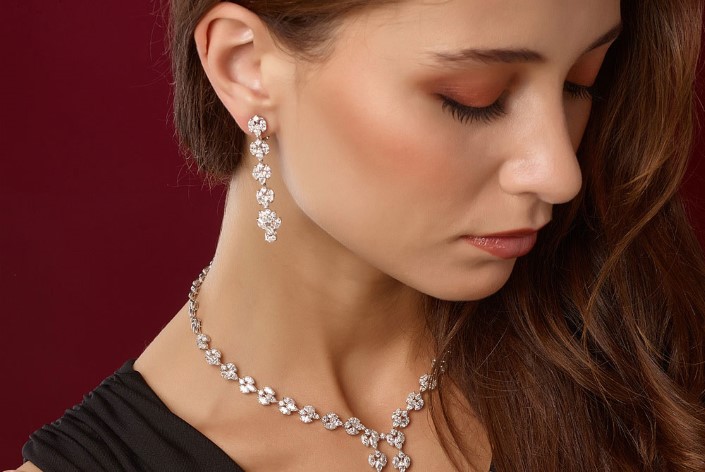
Recreating these conditions brings the crystal up to its fully matured state. The HPHT process involves a careful positioning of the diamond by highly-trained gemologists and scientists into a particular containment cube surrounded by extreme heating mechanisms. The cube is then placed in a type of press that applies the same amount of pressure that the earth would use which creates the right environment for forming diamonds. This process brings the diamond up to its most, desirable, colorless state, and produces the mature diamond possible. The expression of stating ‘mature diamonds’ is not widely known, but they are defined as those having D –E -F–G up to H color grade. An HPHT process simply finishes what nature really began. The HPHT diamond maturation process is a permanent treatment. Even though heat and pressure are applied to bring the stone up to a natural, high clarity, top light brown (TLB) or top, top light brown (TTLB) to a white color grade, it’s critical to note that these diamonds are not synthetics. The stones were mined from the earth, they are genuine and are 100% natural diamonds—just like you want.
Not all diamond rough can be suitable for the procedure. HPHT color treatment process will only be applied to diamonds exhibiting the highest clarity such like –VVS1 VVS2VS1 VS2. This is a rare category as most stones fall lower than that in clarity grading. The diamonds must also be considered closer to flawless, because of the fact that during the HPHT process, diamonds with abundant inclusions and fractures can be irreparably broken and their surfaces may be become frosted. Even the slightest inclusion may potentially explode in the stone during the process, thus rendering it into dust.
The HPHT process is regarded as the only permanent color enhancement process we have available today. It is the only treatment type that completely saturates the diamond with its color. Unlike irradiated and even coated diamonds, (another commonly used process to routinely improve the diamond’s appearance), HPHT diamonds are impervious to further unintended change and need no special handling to maintain their resilient color. By contrast however, irradiated diamonds are often prone to color-fading at high temperatures. Both irradiated and/or coated diamonds cannot be polished or recut later one without it affecting their color.
Are there advantages to Buying an HPHT diamond?
We see three main benefits to selecting an HPHT diamond among the many choices a consumer is offered today Let’s look at the top benefits and see how that fits into your preferences.
- The primary benefit of buying an HPHT natural diamond is the ability to purchase the highest clarity and whitest diamonds offering at an average savings from 45-70% off. For example, a round brilliant stone– a 1.51-ct D VVS1 natural diamond costs nearly $33,000 from an online vendor, whereas the same diamond with equal quality traits treated by the HPHT color process may sell also online for something closer to $1,500. That presents a whopping savings of something closer to 65% less than its natural un-treated counterpart.
- Natural fancy colored diamonds while being wildly popular today and very desirable are still extraordinarily rare making them extremely expensive, so they are affordable to only a select high net worth consumers. But now with the HPHT process delivering stunning diamonds today, they have become affordable to everyone.
- HPHT is a specialized process which mirrors nature, and quite similar to the natural growth process of all mined diamonds. It achieves the desired results by putting the diamond back into the environment in which was formed.
In short HPHT diamonds are genuine, earth-mined diamonds having undergone treatment to enhance them in every way and make them become the diamond you often prefer over other products. They are ideal for diamond consumers who want top color and clarity, however at a substantially lower prices, and accompanied with GIA or EGL (or other independent lab) certificates.

Diamonds are simply… one of Mother Nature’s most dazzling gifts to us. They have been treasured since ancient times. And there is nothing else on earth that captures light and reflects brilliance better than a well cut, natural diamond straight out of the earth. The most beautiful diamonds are thought of as luxury items naturally and are well outside of most people’s reach. But is this really true if you have access to either laser treated diamonds or HPHT diamond products? Modern technology with its ability to improve on diamonds’ clarity and color disproves this is a myth by offering laser treated diamonds and HPHT diamonds that are both affordable and gorgeous.
Who knew there are affordable, accessible alternatives to a traditional diamond?
With advancements in technology consumers get the benefits. There are certain natural diamonds that undergo procedures geared to improve color or the appearance of its clarity. Why would you want to learn more about these diamond milestones? The answer is quite straightforward and anyone with a budget for diamond buying knows that answer all too well. Saving money while still knowing that your diamond is natural—the real deal, and one that can be treasured for a life-time, at an affordable price is the best news ever.
These 3 diamond types that are available on to the market today have proven the test of time.
- GIA Certified Natural HPHT Diamonds
- Clarity Enhanced Diamonds
- Laser Drilled Diamonds
In this informative review, we will review the characteristics that make them ideal for engaged couples and investors alike.
GIA Certified Natural HPHT Diamonds
They are not to be confused with synthetic or what is called lab-grown diamonds. GIA certified natural HPHT diamonds are increasingly sought-after by erudite diamond shoppers and investors. Naturally grown HPHT diamonds are desirable for both a remarkable beauty and permanence of treatment. It is rare to find an HPHT diamond with less than VVS2 clarity or graded lower than an F color. The clarity is intrinsic to the crystal, having come out of the earth with extremely high clarity and the most desirable molecular structure.
What is Clarity Enhancement?
In this case a high refractive index (RI) glass-like material is introduced into surface-reaching feathers of a diamond crystal to reduce their visibility. This treatment is most effective on extremely thin cracks in diamonds. Since the filling material is more apparent in crystal cavities, laser drill holes and such, this filling material literally makes the cracks disappear.
Can enhancements be identified?
The “flash effect” on the diamond seen when observing it nearly parallel to the plane of the filled fracture usually appears as bright blue against a brighter background; and as yellow or orange in color against a dark background. The optical effect of clarity enhancement treatment can be best viewed with 10X magnification under a focused beam of intense light.
Irradiation
What is it? Diamonds subjected to this method are exposed to a source of radiation to improve or introduce a desired color.
Variations of the standard process Artificial irradiation is most often performed on cut stones, although rough (as they come from the ground) diamond crystals may also be irradiated. This treatment (often followed by heat treatment) is used to produce colors like pink, blue, green, yellow, brownish-orange greenish-yellow, and even black tones.
Treatments for enhancing diamond clarity via Laser Drilling
Diamond manufacturers now routinely employ lasers to remove or just lighten a dark-colored inclusion by drilling a tiny hole into the site of that blemish. When they’ve done this, the laser may actually result in the inclusion vaporizing. However, the laboratory may then apply bleach or some kind of acid to lighten the inclusion even further. Laser drilling can transform included diamonds into something much more marketable; but the resulting laser drill hole is now considered to be a clarity characteristic. The drill-hole can of course be filled with foreign material and become more visible in the end. Laser drilling is considered to be a permanent procedure since the drill hole it created cannot be removed. Another step may be warranted after the laser drilling is complete. Sometimes then, the diamond is fracture filled with a clear glass-like material.
Fracture filling
By infusing a molten leaded glass-like substance into a diamond’s fractures – this is the most often used diamond treatment to enhance the stone’s clarity. Fracture filling of surface reaching cracks of course can be effectively disguised through fracture filling. There’s another use for this specialty process. It might also be seen to benefit the consumer who accidentally cracks their own diamond. This effective treatment can last for years with proper care and handling.
High Pressure, High Temperature (HPHT) -v- Laser Treatment on Diamonds
As you can see, both HPHT processes and modern laser treatment are two effective means to beautify and diamond helping it to turn into a gorgeous sparkling stone that everyone admires. They are two separate treatments used to tackle two different kinds of diamond conditions. But the result is that consumers have a more affordable option for diamond purchasing today than at any other time in history. HPHT and laser treatment allow shoppers to own a breathtaking diamond like many found in nature. But those found in nature without treatment will cost tens of thousands of dollars more than the same looking diamonds that have undergone either laser drilling or HPHT treatment. Staying within a budget is a real option today—yet you can still count on having a gorgeous diamond at the same time when you consider buying an HPHT diamond or one that has undergone laser drilling. The choice is yours.

